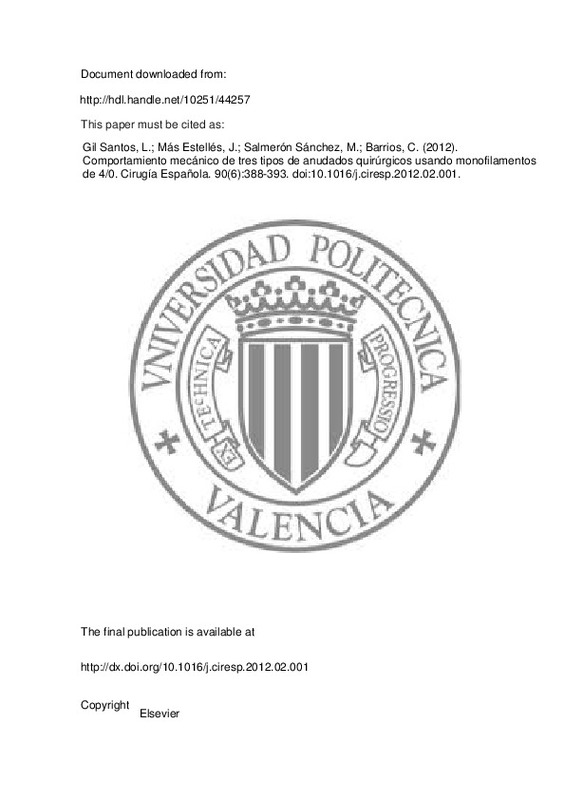|
Resumen:
|
[ES] Objetivo
Estudiar experimentalmente mediante ensayos mecánicos el comportamiento de 4 tipos de monofilamento con 3 diseños de nudo, muy frecuentemente utilizados en cirugía.
Material y métodos
Se eligieron 4 ...[+]
[ES] Objetivo
Estudiar experimentalmente mediante ensayos mecánicos el comportamiento de 4 tipos de monofilamento con 3 diseños de nudo, muy frecuentemente utilizados en cirugía.
Material y métodos
Se eligieron 4 monofilamentos de 4/0, dos de nailon y otros dos de polipropileno. Sobre cada hilo se realizaron 3 diseños de nudo. Un primer diseño (D-S-S) consistía en un seminudo doble (D) seguido de uno simple (S) en dirección contraria y un tercer S a su vez en dirección contraria. La configuración del segundo diseño fue D-S-D, y la del tercero, S-S-D. Se realizó un ensayo mecánico de rotura por estiramiento del hilo a una velocidad de 4 N/s, registrándose la fuerza y la deformación en intervalos de 100 ms.
Resultados
En los ensayos sobre hilos con nudos, existía una disminución de la fuerza y deformación de rotura con relación a los hilos sin nudos. En todos los casos, la rotura del hilo se producía en la zona del nudo, presumiblemente debido a daños causados al hilo durante el proceso de anudado. El nudo D-S-D fue el que mayor resistencia presentó con hilos de polipropileno, y el S-S-D el que mayor resistencia proporcionó con hilos de nailon.
Conclusiones
Los hilos de polipropileno, con nudos D-S-D, estarían más indicados para suturar tejidos que debieran soportar grandes fuerzas y con poca deformación de la sutura (por ejemplo, tendones). Los hilos de nailon, con nudos S-S-D, estarían mejor indicados para tejidos que tuvieran que soportar fuerzas más pequeñas y que precisaran de mayor elasticidad (por ejemplo, piel).
[-]
[EN] Objective: To experimentally study the behaviour of 4 types of monofilament with 3 knotting techniques, very often used in surgery, employing mechanical tests.
Material and methods: Four 4/0 monofilaments were ...[+]
[EN] Objective: To experimentally study the behaviour of 4 types of monofilament with 3 knotting techniques, very often used in surgery, employing mechanical tests.
Material and methods: Four 4/0 monofilaments were chosen, two of nylon, and the other two of polypropylene. Three types of knot designs were made with each thread. The first design (D-S-S) consisted of a double half-knot (D) followed by one single (S) in the opposite direction, a third S in turn in the opposite direction. The configuration of the second design was D-S-D, and the third, S-S-D. A mechanical fracture test was performed by stretching the thread at a rate of 4 N/s, the force and deformation being recorded at intervals of 100 ms.
Results: There was a decrease in the force and deformation in the tests on threads with knots compared to threads without knots. In all cases the rupture of the thread occurred in the knot area, presumably due to damage caused to the thread during the knotting process. The D-S-D knot had the greatest resistance with polypropylene threads, and S-S-D provided the greatest resistance with nylon threads
Conclusions: Polypropylene threads, with D-S-D knots, should be more indicated to suture tissues that have to support great forces and with little deformation of the suture (e.g., tendons). Nylon threads, with S-S-D knots, would be better indicated for tissues that have to support smaller forces and that require greater elasticity (e.g., skin). (C) 2011 AEC. Published by Elsevier Espana, S.L. All rights reserved.
[-]
|







![[Cerrado]](/themes/UPV/images/candado.png)


